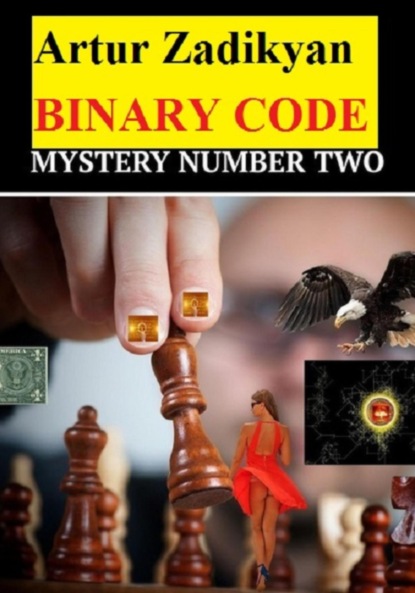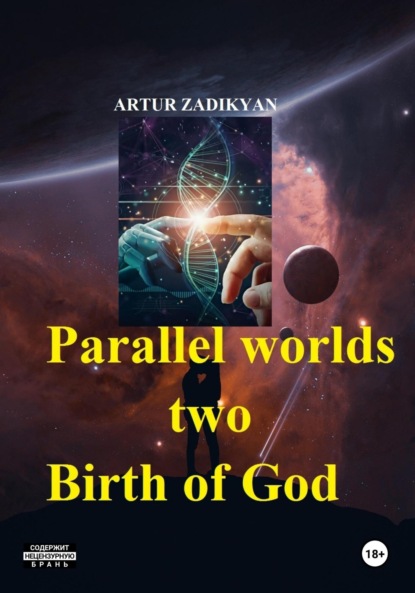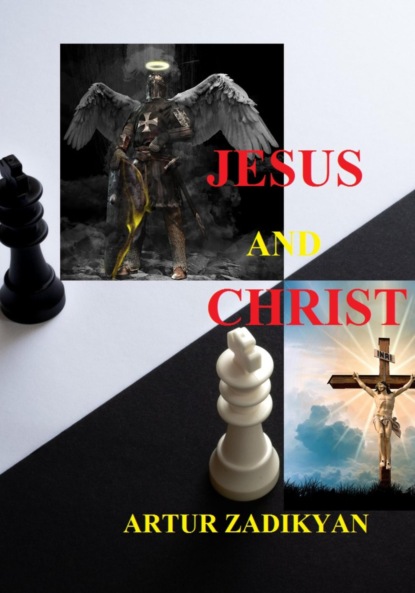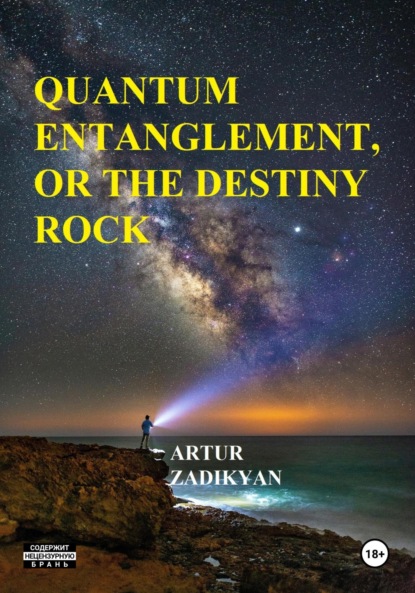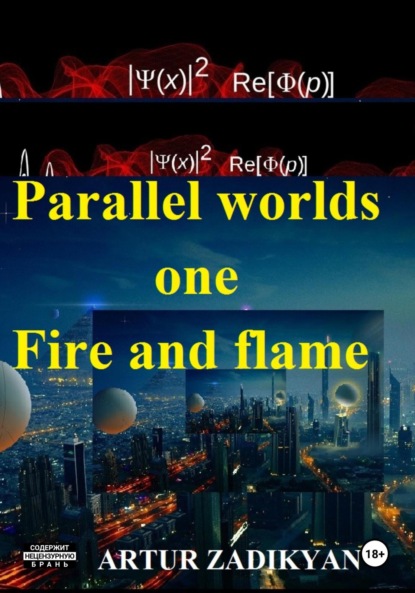
Полная версия:
Artur Zadikyan Binary code Mystery number three
- + Увеличить шрифт
- - Уменьшить шрифт

Artur Zadikyan
Binary code Mystery number three
Part Six: Binary Code-6. Ringing Cedars of Russia
Blood, soil or status? Which is more important to whom? Where is your homeland? Who are you by blood? Is your homeland where you were born? Many people born in the USSR believe that someone took their homeland away from them. In this book I write about those who regret it and plan to strike back. Perhaps they are wrong, perhaps mistaken in their definition of the enemy.
Rutra is on the trail of a mysterious ZKR organization, which you should already know about, and now he's going to infiltrate them, but in order to do so, he has to go to the Kola ultra-deep, and the stake is his life! His weapons are superhearing, super vision and mental communication with artificial intelligence.
You are what you think you are
Chapter 1: The Dulles Plan

After a couple of days, Ruthra was quite stress-free. He was even beginning to enjoy it, going through virtual reality. He had his own plan, and the main thing was that he had to develop a precise criterion for realizing that he was there. Realizing that it was almost impossible, otherwise it wouldn't be virtual reality, Ruthra decided to try to play by his own rules in any situation where there would be a similar scenario. He decided to change the course of events as he saw fit, but first he decided to identify, calculate and find the third party fighting in Red Square. To be more precise, they could not be called warring in the literal sense, but they were definitely a party to the conflict. Having analyzed the last session, he found the initial thread through which he intended to find the very "tangle" of strange rebels, who, if carefully analyzed, acted in tandem with the security forces. At least (and most likely) – they were commanded by one headquarters. Strangely enough, they were not hiding, and from their faces, which they did not hide, Rutra recognized their "spiritual" mentors. They were representatives of the fierce opposition, its liberal, pro-Western part. They were about to have a "big gathering", they were going to hold an emergency meeting, not anywhere, but in Switzerland, which had already become a classic of the genre. To get to their meeting was not very difficult either, it was enough to have a high-ranking patronage, which they loved so much. It was more difficult to calculate "people like him", "hanging out" between them, and even more difficult to calculate those who could trust all three conflicting parties in virtual reality. And there were bound to be some. Ruthra was almost certain of that. Of course, the Echelon-1 system would be aware of such subjects, but in a situation where there was clearly a conspiracy, asking for information might be suspicious for conspiracy purposes and might scare the "game" away. Ruthra was sure that previous searches had failed at this sort of thing, i.e., declassified.
A few days later, he appeared at their meeting as a low-profile but very influential official of the Kremlin administration. On him was to depend "coordination at the very top", admission to the elections and passage to parliament of their representatives, who, as everyone knew, were representatives of the international financial oligarchy, the American elite.
At the meeting, while still on the sidelines, as befits an opposition of such status, fashionable topics, statements, inferences, and assertions were made about the wrong path of development that the current Russian authorities are leading the country down. In order not to waste much time, Rutra "turned on" a special matrix vision, "photographed" and transmitted the material to the ISU-A2, and in a couple of minutes he could "pull" information about any "delegate" from his memory. While he was analyzing who was who, the conference itself began. After a brief introduction, the moderator introduced the first speaker.
– I now give the floor to our guest of honor, Mr. Medvedev, President of the Future of Russia Foundation.
– Good evening, – he began his speech. – Despite the fact that, proclaiming freedom in our country, the leadership veiledly pursues a policy of dictate, you were not afraid and came to the meeting. I am very glad and grateful to you for this. I want to say with all certainty that in today's Russia, in its power structure, only the faces and masks have changed, but the content has remained the same as it was "Gebesh". Forgive me for this terminology. I think everyone already knows what it means. I want to demonstrate how they use the propaganda they love so much to denigrate Western democracies. My story will be about the so-called Dulles Plan, supposedly a testament to the plan for Russia and its consequences. So. The Dulles Plan as a mirror of the "Soviet conspiracy". After the collapse of the USSR we began to quote Allen Dulles' "secret report" on the "American post-war doctrine against the USSR" – either in 1945, or in '48, or in '53: "…We will throw everything we have – all the gold, all the material power to deceive and fool people. We will imperceptibly replace their values with false values and make them believe in these false values. We will find our like-minded people, our allies in Russia itself. Episode after episode will be played out grandiose in its scale tragedy of the death of the most unruly people on earth; the final, irreversible extinction of its self-consciousness". This quote, but in a much longer form, is adorned on all left- and right-patriotic sites of Runet. It has been publicly read out by such prominent personalities as Nikita Mikhalkov, Gennady Zyuganov, and Andrei Karaulov. Although it has already been found out that this passage is taken almost unchanged from the last edition of Anatoly Ivanov's novel "The Eternal Call", published in 1981. Here this plan is outlined by an SS Standartenführer, formerly the head of the Tomsk security service. It was called the Dulles Plan in Boris Oleinik's anti-Gorbachev pamphlet "Prince of Darkness", with the explanation: "…for 10 years these words were thrown out of the novel 'The Eternal Call' by the censors under Kremlin-Zionist control." And the first outline of the Dulles plan was the monologue of the American General Dumbright in the spy novel Dold-Mikhailik's "And One is a Warrior in the Field": "Let's arm the lovers of a sharp word with anecdotes ridiculing their present and future. Poison the souls of the young with disbelief in the meaning of life, awaken interest in sexual problems, lure them with such lures of the free world as fashionable dances, beautiful rags, special character records, poems, songs. Quarrel the young with the older generation."
The speaker fell silent and after a few seconds continued:
– If the authors of "The Call" and "The Warrior" had read the so-called foreign press, and even in English, one might have thought that they had simply rewritten a document called "The Communist Rules of the Revolution". These "Rules," supposedly discovered by Allied troops in Germany in 1919, appeared in English newspapers in February, 1946, and were reprinted hundreds of times thereafter: "1. To corrupt the youth; to lead them away from religion. To instill in them an interest in sex. 2. Destroy old moral values by false arguments… 5. Distract minds from politics by turning their attention to sports, sex books, games, and other unimportant pursuits. 6. Put all media under their control. 7. Destroy people's faith in their natural leaders by portraying them in a shameful, ridiculous and offensive way." There were other documents of the same nature. On August 24, 1960, the Los Angeles Herald published excerpts from the pamphlet "Brainwashing. An Outline of the Russian Guide to Psychopolitics." The pamphlet was published in New York in 1955 by the Ron Hubbard Foundation, science fiction writer and founder of the Church of Scientology. The Russian Guide to Psychopolitics stated, "By making drugs of all kinds available, by giving the adolescent alcohol, by praising his wildness, by feeding him sexual literature, the psychopolitician can cultivate in him the tendency to disorder, idleness, and useless pastimes that we need, and induce him to choose the solution that will give him complete freedom in all things – that is, Communism. If you can kill national pride and patriotism in the rising generation, you will conquer this country." The publication became the subject of FBI correspondence. A memo on the case ended: "The April 24, 1951 issue of the Times Herald reported that Hubbard's wife testified in divorce proceedings that he was 'hopelessly insane' and subjected her to 'torture under the guise of a scientific experiment.'" According to the article, competent medical professionals recommended that Hubbard go to a private clinic for psychiatric observation and treatment of his mental disorder known as paranoid schizophrenia." This conclusion should have been shared with anyone quoting the Dulles Plan. Although, in principle, it may be of no use to schizophrenics. They don't know they're schizophrenics. So somehow this is how Kremlin propaganda works. Draw your conclusions, and I'm done. Thank you for your attention.
The speaker finished his speech, nodded his head as if to bow and left the stage. After him, several other experts on Western democracy spoke, but Ruthra had nothing to gain by listening to them, biding his time. His brain, with the help of the ISU-A2, had long since finished processing the characters. Although there were quite influential people at the meeting, still their influence was minuscule compared to the global problem he was researching. Rutra carefully left the meeting without attracting attention, although the rules for entering this circle of people of such rank made it impossible.
Chapter 2: The Kola Superdeep

Already on the airplane, returning from Switzerland to Moscow, thinking about the ZCD, Rutra recalled his conversation with Omni. He remembered a fragment when he came up and in parting said one more of his assumptions: "If you want to find any associates of Alikhanov, I can advise you to look for them among the discontented, for example, nationalists or anti-globalists, although it is difficult to suspect the scientist in this. Perhaps they have socialized in the past." Rutra remembered that they had said goodbye with a slight sense of mutual distrust. Ruthra decided to check this thread as well, since so much work had already been done. As the proverb says, what the heck.
In a couple of hours, Zero had prepared an analysis of the conversations, travel routes, and veiled conversations of virtually all former and present scientists, military officers, intelligence officers, and persons with radical (and not so radical) nationalist statements, even if they were made in secret. From all the analysis, Rutra concluded that the most suspicious was that the most inconspicuous of them periodically visited abandoned military and especially significant Soviet-era sites, ostensibly to view the great achievements of the Soviet era. Additional analysis revealed that two sites were particularly active and secretive. These are the Kola ultra-deep well and the Protvino scientific center near Moscow, namely, a semi-abandoned ring tunnel 21 kilometers long, lying at a depth of 60 meters.
First of all, Rutra decided to check Kola, since there were no reports about the "gathering" there from all the structures. Rutra logically decided that her "visitors" could not be homegrown underground fighters. Intuitively, Rutra realized that the case was worthwhile and should be taken seriously. First, he wanted to "inspect" the site.
What was the well? The brain's "vault" gave out the following information: "The Kola ultra-deep well is the deepest in the world. Its depth is 12262 meters. It is located in the Murmansk region, 10 kilometers west of the town of Zapolyarny. The well was drilled in the northeastern part of the Baltic Shield solely for research purposes in the place where the lower boundary of the Earth's crust comes close to the Earth's surface. In the best years, 16 research laboratories worked at the Kola ultra-deep well, and they were personally supervised by the USSR Minister of Geology. In 2008 the facility was abandoned. The Kola ultra-deep well is associated with many improbable legends – about the "well to hell", from the bottom of which the screams of sinners are heard, and the drills are melted by the flames of hell".
To get there with the group that was meeting there covertly, Rutra contacted Sergei, a GRU officer that Hent had recommended to him as an assistant; someone he had "worked" with on virtual reality operations. It was a real person from the OAM department. There was no time to investigate why Rutra didn't know that.
Rutra did not hold general meetings, as was the rule at Zero. He didn't have time to do it because of his schedule, and the lists were controlled by the records department, whose head, an old, battle-hardened general, Rutra trusted completely. He shuffled the deck so that the staff of one department did not know who was in the other.
According to the legend in this operation, Sergei was a radical oppositionist, a nationalist, so he very quickly introduced Rutra to "his own" as an ardent anti-Semite. According to the rules of the secret organization – no one in the subsequent chain of contacts should have known the real data of the new associate. He had to be introduced to his superiors by an active member of the brigade who had the right to recruit. This was done without the knowledge of the person being checked. After the new member was verified by his superiors, if he was approved as a member of the team, he was given a secret name, a legend of origin and activity. Rutra learned from Sergei that the "bosses" were interested in influential personalities, preferably connected with the special services or the military-industrial complex. Rutra was presented to them as an employee of the Foreign Intelligence Service, who, because of his patriotic and world outlook views, had fallen into disfavor with the command and was ready to support and help true patriots in saving the Motherland for the sake of liberating Russia from the "yoke of invaders". For this Rutre was invented a wonderful legend, which was not particularly different from the true one, as in post-Soviet Russia there were more than half of them. Namely – labor and political activity of his parents, associated with the Communist Party, the military past of his grandparents, and his Komsomol past. Since the past of the Zero employees was simply "erased" from history and another one was invented instead, Rutra was not afraid of being exposed: the past matched. According to legend – Rutra was given a secret name: Yuri Gagarin (or Cosmonaut).
After the third meeting with the "like-minded" Sergei set them a task: they needed to find out – who was secretly meeting behind their backs and where. Sergei's specialization was a bit off, as he was only doing this domestically to improve his skills for such events abroad, so Rutra started meeting with "his friends" without him. He soon found out that the "especially literate", as they put it, and financially able were going to another convention. Rutra asked to meet with them, to which he was told that he needed a recommendation from "someone close to him." When asked if Sergei's recommendation was not enough, he was explicitly told that it would be a good idea to back up this recommendation financially. Rutra agreed, with a counter-condition: to help him to play a play to borrow money at interest from a Jew with the Ukrainian surname Andreenko, whom they were to "screw". This was an excellent way of showing them a positive side.
Rutra "agreed" with Andreenko under pressure from an acquaintance in the Prosecutor General's Office in advance. Soon the necessary sum was given to his new "friends" and in return they received the consent of the "older brothers" to attend their meeting. From the leader of the group, nicknamed Akella, Rutra learned that the leader was Professor Muromov, who wished to meet with him. Rutra agreed and went to the meeting a day later.
Muromov himself was unable to meet him, so Rutra had to impress his close comrade in the community. He was a long-retired scholar, a dry, thin, tall grandfather with a clear expression. They talked, and Rutra was well versed in history, though in some places he had to secretly use Isa's help. Ruthra had a very favorable impression of the man, and he said nothing vile. He was a true patriot, though a bit nationalistic; he explained that all nationalistic and anti-Semitic manifestations had grown out of the opposition to the Zionist worldview. The goal was achieved, and four days later Rutra attended their meeting in Protvino.
Nothing particularly "grandiose" or secret was going on there. The conversation was mostly about Russia's "traitors and invaders," as one might hear at a market, a parade, a party of law enforcers, or a meeting of bankers and ministers. Rutra realized he was being tested, and that pleased him. Their conspiracy system was professionally practiced.
Six months later, when Ruthra had had enough of these meetings and had begun to be distracted from other points of the test, he was unexpectedly invited to a small talk. The meeting was to take place in Protvino, in an underground tunnel. Kola was "scanned through", nothing important was going on there, though Rutra "smelled" something wrong, suspicious individuals did visit the place, but only alone. They were retired intelligence officers. His intuition told him that something important was going on, though it could have been a diversionary maneuver to catch the tail.
Rutra went to Protvino. In a dark room he was "interrogated" and "examined" by persons, some of whom were scientists, humanitarians, and artists, but the rest were clearly from the security services. And many of them, judging by their behavior, manner of conversation, and thinking, were or were members of secret and power structures. What kind of "hypnosis" they possessed, what secret equipment they used, Rutra could not determine precisely. But what they used, he calculated and passed the test perfectly. After another "interrogation" and interview, he was given "documents" that he was a member of an amateur amateur art group and a participant in the annual fair. Thus, observing complete secrecy, not sleeping at home, disconnecting the telephone, which, of course, he had warned in advance, Rutra found himself on Kolskaya. Namely, in a reorganized room at the Kola ultra-deep.
It was a gathering of seemingly quite literate people, mostly middle-aged and elderly, although there were also many young people. On the stage, at the table sat seven people, one of whom stood out because he was leading the process. It was Professor Muromov, just as he was described; tall, with a scruffy head of hair and small eyes, wearing glasses with large translucent glasses, a little heavy, but with a military bearing. When everyone was seated, he began the meeting by greeting the audience.
– Good afternoon, dear friends. I congratulate you – in spite of everything, we have managed to convene our congress. On it we should adopt our further strategy of action, but in the meantime I and our guests will give some lectures. I hope there are no objections to the organizational issues of the board and the protocol, which you should have read in the hall?
Approving voices were heard in the hall.
– I remind everyone to be extremely careful. According to information received from our security service and like-minded people from the authorities, we are being hunted, the chain dogs of the "Jewmassons" are on the trail, so everyone must act like Matrosov in case of failure. So, I will speak first. First, I will cite a famous statement of Pastor Martin Niemöller: "When they came for the Communists, I did not care, I am not a Communist. When they came for the Social Revolutionaries, I didn't care, I'm not a Socialist. When they came for the trade unions, I did not protest, for I am not a trade unionist. When they came for the Jews, I kept silent, I'm not a Jew. And when they came for me, there was no one else to protest." Notice that they came for the Jews last, even though they shouted all over the world that Hitler destroyed them first! What, were they sitting around waiting to be killed? Didn't he offer them to leave first? This is the great Jewish scam to justify the creation of Israel. Now let's understand who is in charge in the US and NATO, and at the same time other countries that the US has colonized in various forms to date? Who is responsible for all the major atrocities of the 20th century? Who profited from wars, coups and crises?
"Well, yes, now I see why Alexander Ivanovich said they didn't have a single party man, that you can't serve two gods," Ruthra thought.
– Who is to blame for all the troubles of mankind, who serves Satan, who pushes people and nations together, who organizes wars? The answer is known – a number of clans or clubs of Jews: Rockefellers, Morgans, Rothschilds, Kuhns, Loebs, Goldmans, Mellons, Saxons, Dupons, Lehmans and others. These are the ones who have determined the course of humanity's development in the last 150 years.
"Here we go," Ruthra thought. He had an idea of the contingent that had gathered, and he had an idea of what topics were relevant to them. They weren't the only ones, though; they hadn't changed in well over a hundred and fifty years. So Rutra didn't really delve into it, his thoughts were occupied with the general factors that lead people to such conclusions. In this context, he began to detect a more momentous meaning in some of Mithra's statements or sayings. At times his hearing returned to the hall. Finding no new food for thought. the mind drifted off into other reflections.
– …It used to be believed that to control global financial flows, one had to have a controlling "stake" or blocking stake in it, which is physically impossible. A mathematical study by Swiss scientists has shown that for global influence it is enough to control 2-3 percent of the world financial web. And this is quite real, you just need to know how to do it. That's all for now.
The speaker finished his speech, the presenter thanked him, switched the microphone to himself and introduced the next speaker.
The floor was given to a rather famous person in the past – a former international journalist. He came to the "stage" from the audience and began his speech.
– Good afternoon friends, comrades. The topic I have prepared is called "The Three Classes of People". And now you will understand why. I want to familiarize you with some fragments of an interview with an American journalist, a correspondent of several news agencies accredited to the UN, which relate to the topic we are considering. So, I read, "There is a revitalization of the anti-globalization front around the world. The movement, which emerged in opposition to the formation of the world power of bankers, is a serious enough phenomenon, and it is impossible to ignore it".
Ruthra was getting a little bored. He was waiting for more. He knew about the man the speaker was talking about and his organization, so he was still preoccupied with his own thoughts, only listening from time to time.
– …Their favorite is Gorbachev. They are currently building a Masonic complex for him in San Francisco. They're predicting that he'll be General Secretary of All Religions. Gorbachev has received two King David Awards. There are not even any Jews who have received two awards at once. And the "non-Jew" Gorbachev received – for services to the Jewish people. All this was done within the framework of the Harvard Project… the words of American professor Nicholas Murray Butler, quoted in Ivor Benson's book "The Zionism Factor": "The world is divided into three classes of people: a very small group of people who direct the course of events; a slightly larger one – which follows the course of events; and the majority, which does not understand what is happening"… there is one "puppeteer" behind all of them… some secret group is not averse to organizing 1917 on a global scale… Economists in different countries have suspected before that the world is being spun by several giant firms… It is now, in the crisis, that it is decided – who is in charge. Crisis is when resources are scarce and the struggle for them intensifies. That's how animals on the savannah fight at a dried-up watering hole. In general, I think this is enough for you to understand the main idea. Draw your conclusions, and with your permission, that's all I have.
